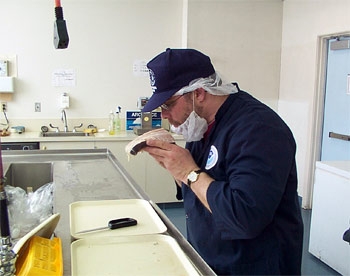
In a June 2010 telephone survey of 1,076 consumers conducted by University of Minnesota’s Food Industry Center, Louisiana State University AgCenter and the National Center for Food Protection and Defense, 89 percent said they are concerned about the spill’s effects on gulf seafood, and 50 percent are “extremely concerned.” When asked about their own eating habits, 54 percent of respondents said the oil spill has affected their seafood consumption somewhat, 44 percent said they will not eat gulf seafood, and 31 percent said they will eat less seafood regardless of its origin.
The gulf produces blue crabs, crawfish, oysters, shrimp and about 86 species of fish including albacore, channel catfish, red snapper and tilapia. Consumers are worried about crude oil and dispersants contaminating the food, but experts say gulf seafood is safe to eat.
“There has been no evidence of tainted seafood entering the marketplace,” says Pamela Tom, California Sea Grant advisor. “Seafood from the gulf has never been as highly inspected as it has been now. Harvest waters are re-opened only after extensive government testing proves that the seafood has not been tainted by oil from the spill.”
The US Food and Drug Administration (FDA), National Oceanographic Atmospheric Administration (NOAA), and the Gulf Coast states cooperate in unison on a protocol to determine when closed federal harvest waters can be re-opened.
Federal inspectors routinely do sensory evaluations or “sniff test,” a rapid method of testing seafood. Highly trained regulatory inspectors can detect oil taint within seconds. More time-consuming, sophisticated chemical analyses of the seafood are also used. Recently, the California Animal Health and Food Safety Laboratory, operated by the UC Davis School of Veterinary Medicine for the State of California, was selected by the FDA to conduct chemical analyses in monitoring seafood from the Gulf of Mexico for toxins related to the oil spill.
To help prevent oil-tainted seafood from reaching consumers during the oil spill, Tom joined a national team to disseminate information on seafood safety steps and monitoring for contaminants in seafood shipments and harvests from unapproved waters. She worked with the FDA, the NOAA Seafood Inspection Program, Louisiana State University and the University of Florida to assemble an oil spill website with resources for gulf fish growers, harvesters, processors and seafood buyers.
So how can consumers tell if seafood is good to eat?
“Buy from reputable dealers,” Tom advises. “Smell it. If seafood smells a little fishy, it could be past its prime, but may still be safe to eat.”
At home, consumers also need to practice sanitation and proper temperature cooking and holding controls. Mixing raw seafood products with cooked product is a formula for disaster, she says. Cooked foods should be kept separate from raw foods, which may have natural bacteria present. Spoilage bacteria compete with pathogenic bacteria, but proper cooking of raw fish at 145 degrees F for 15 seconds destroys the bacteria. If pathogens are re-introduced after the seafood is cooked, under the right conditions pathogenic bacteria can grow and may lead to foodborne illness.
“Some pathogens will grow in your body, while other pathogens may create toxins in food,” Tom says. “Some toxins are heat stable and some are not. Food safety is a very complex situation and some consumers are more susceptible to foodborne illness than others.”
Safe cooking and holding practices at home include placing seafood on ice or in the refrigerator or freezer soon after buying it. The temperature holding range should be below 40 degrees F or above 140 degrees F. Bacteria that can cause foodborne illness can grow quickly at warm temperatures between 40 degrees F and 140 degrees F.
Consumers can find more information about seafood safety and quality at UC's Seafood Network Information Center website.